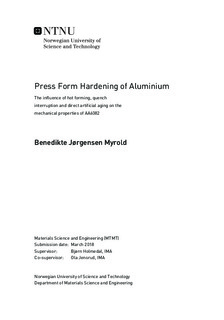| dc.contributor.advisor | Holmedal, Bjørn | |
| dc.contributor.advisor | Jensrud, Ola | |
| dc.contributor.author | Myrold, Benedikte Jørgensen | |
| dc.date.accessioned | 2018-12-06T15:02:05Z | |
| dc.date.available | 2018-12-06T15:02:05Z | |
| dc.date.created | 2018-03-19 | |
| dc.date.issued | 2018 | |
| dc.identifier | ntnudaim:18148 | |
| dc.identifier.uri | http://hdl.handle.net/11250/2576499 | |
| dc.description.abstract | The automotive industry is in need of new lightweight solutions to meet stricter regulations regarding reduction in greenhouse gas emissions. Replacing steel components with age-hardenable high-strength aluminium alloys may significantly reduce the weight of a vehicle. Hot forming and in-die quenching of aluminium is a method under development with an overall aim to provide more effective and cheaper solutions for production of aluminium components for automotive applications. The method also introduces improved properties compared to cold forming in terms of geometrical tolerances, formability, ductility, springback and microstructural control.
Experiments were conducted on an extruded 6082.25 aluminium alloy profile to investigate the behaviour of the material during integrated hot forming and in-die quenching under various conditions. A flat steel pressing tool, with built-in channels for water cooling, was designed, built and attached to a hydraulic driven press. Samples were brought directly from solution heat treatment to the tool for simultaneous quenching and deformation. A feasible and reproducible test procedure was developed for the press tool experiments.
By shortening the closed-die time during integrated deformation and quenching from solution heat treatment before direct artificial aging, significant time might be spared in an industrial production process.
The effect of reduced closed-die time was investigated by interrupting the quenching from solution heat treatment at temperatures between 25-200°C before subsequent age hardening. The effect of direct artificial aging was investigated by bringing one set of samples directly to oil bath for artificial aging after quenching from solution heat treatment. A second set of samples was stored at room temperature for 30 minutes before artificial aging. It was found that quench interruption at temperatures below 150°C does not affect the alloy properties in a negative manner. Neither direct artificial aging imposes diminished properties of the alloy. | |
| dc.language | eng | |
| dc.publisher | NTNU | |
| dc.subject | Materialteknologi (MTMT), Materialutvikling og -bruk | |
| dc.title | Press Form Hardening of Aluminium - The influence of hot forming, quench interruption and direct artificial aging on the mechanical properties of AA6082 | |
| dc.type | Master thesis | |

